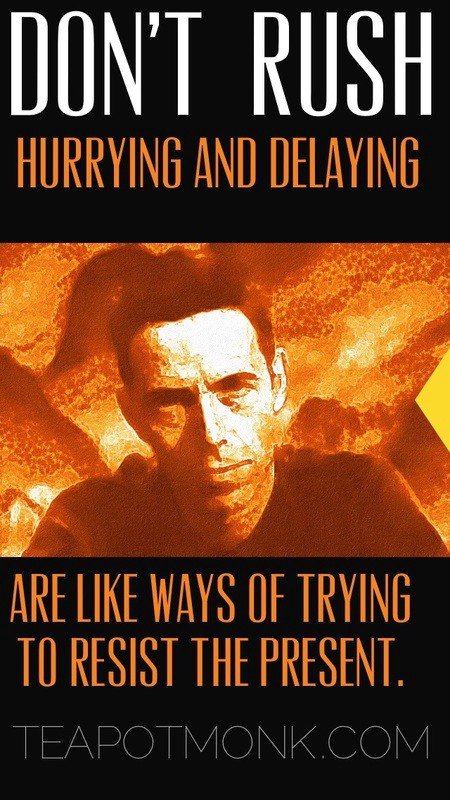Learn 5 Simple Ways to Slow Down
Looking for a simple way to avoid hurrying, delaying? Prefer to go slow and avoid what Alan Watts calls: Resisting the present? I know what you mean…
Everything seems to be getting faster: Broadband speeds, processor speeds, train speeds and digital needs.
Download times, political crimes, climate change, interchange, stock exchange.
Streaming video, ab initio, periscope, IGTV — it’s all in the moment.
Blink — and it passes you by. (I hasten to add).
But if Tai Chi teaches us one important lesson in the 21st century — irrespective of style or school, satin suit or kimono, pony-tail or shiny pate, martial or health emphasis — it is to slow down. Uniquely amongst the arts, the practice is the product in Tai Chi. The goal is in the going.
The trouble is — although we nod, smile knowingly and accept we have been scurrying around like naughty mice — within the hour we are back to our frantic lifestyles again, bemoaning the absence of space and time in this digital age. Alan Watts said:
“We crave distraction, a panorama of sights and sounds, thrills and titillation into which as much as possible must be crowded in the shortest possible time. “
So the teapotmonk presents his 5 quick tips for slowing down in an age where we not only consume fast — food, scan read, speed listen (play podcasts back and x2 speed) but even fast nap too.
To help counter the tendency to speed up, get out a pen and paper and scribble down the following guidelines — and use longhand.
1: SLOW DOWN USING YOUR BREATH
First up, is to remember to link all activity to your breath. No, not with a rubber band or sticky tape, but with your mind. Just connect them together. Re-introduce them, they are old friends after-all.
This will result in slowing down your movements, coordinating your body and mind so that the sense of needing to rush begins to dissipate. Once you link movement and activity back to your breath again, that niggling voice of urgency cannot so easily dominate your space.
2: SLOW DOWN BY CHANGING YOUR Shoes
Secondly, change your shoes. Yup, that’s right — change those shoes! Get out of the boots, the trainers (sneakers), or the hiking gear for they separate you from the source of your stability and strength. “Untie the knot” say the Taoist sages of old. I say unite the tie itself and lob it away. Silly things. Oh, and flip-flops are out too, you need something that will securely stay on your feet, not just cling to a single toe and constantly trip you up on stairs and kerbs.
Remove items that cut you off from your environment (unless you live next to a nuclear energy plant or chemical factory, then you may want to do the opposite).
3: Unplug the headphones.
Step back from the noise of life — the traffic, the hum of urban life, the chink of the cash register, the notifications from the digital device, the digital chatter from your time-line. Step back and see if you still have the capacity to hear the beating of the earth around you. If you hear a bird song or insect buzz by, a dog snore, or someone alongside you sigh — then congratulations, you are back on track again.
4. SLOW DOWN BY NOT tryING so hard
Watts said:
“For the perfect accomplishment of any art, you must get this feeling of the eternal present into your bones — for it is the secret of proper timing. No rush. No dawdle. Just the sense of flowing with the course of events, in the same way that you dance to music, neither trying to outpace it nor lagging behind. Hurrying and delaying are like ways of trying to resist the present.”
In other words, don’t worry about the correct moment to do stuff, when you are in tune, the moment will let itself be known to you.
5. SLOWING DOWN: IT’S A Practice.
Alan Watts
Even in the car, going slow can often get you faster to where you to need to be. Sounds contradictory but under specific urban conditions, speeding up just slows you down. Check out the chapter in the re-released and updated Manual of Bean Curd Boxing for more ways to slow down.
HOW TO SLOW DOWN
Yup, no getting away from it, you need to put in the time. Being good at something doesn’t happen by spending more time on Instagram, or though osmosis.
But practice does need to be meaningful and relevant and functional to the 21st century. So make sure your practice is having the results you are looking for. Do a self-assessment.
Remember, it’s one thing running through the Tai Chi form each day out of habit, or doing an hour of QiGong as part of your morning schedule, but then rushing out the door because you are late for work. Did you just cancel out the benefits of the practice? Or take the more Yang-practitioners amongst us — It’s one thing being able to fend-off 6 armed attackers using just a simple posture like “ward-off left” — but it’s another thing altogether being able to diffuse the moment with a lethal Alan Watts quote. Even weapons, like our language, needs updating now and again.


